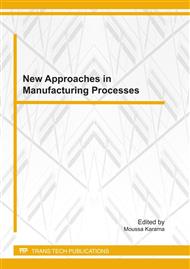[1]
M. Zapciu; M. Paraschiv: Predictive maintenance and use of tracking concept to analyze dynamics of machine tool spindle, in Proceedings of the 11th Int. Conf. – TMCR (2007), p.512.
Google Scholar
[2]
Cl. Bisu, Ph. D. Thesis: Etude des vibrations auto-entretenues en coupe tridimensionnelle: nouvelle modélisation appliquée au tournage, Université Bordeaux 1 and U.P. Bucharest (2007).
Google Scholar
[3]
J.F. Rigal, M. Zapciu, T. Mabrouki, S. Belhadi: Sawtooth chip formation in hard turning and the approach to separate process segmentation and machine assembly vibration frequencies, in Proceedings of the Int. Conference on Manufacturing Systems (2006).
Google Scholar
[4]
G. Sutter, A. Molinari: Analysis of the Cutting Force Components and Friction in High Speed Machining, J. Manuf. Sc. Engineering, Trans. of the ASME, vol. 127 (2005), p.245.
DOI: 10.1115/1.1863253
Google Scholar
[5]
M. Zapciu, J-Y. K'Nevez, A. Gérard: Tracking analysis and predictive maintenance in order to obtain dynamics of machine tool spindle, in Proceedings of the 5th Int. Conference of Advanced Manufacturing Technologies (2007) p.195.
Google Scholar
[6]
C.F. Bisu, M. Ghinea, M. Zapciu, D. Anania: Analyse du comportement dynamique de la broche d'une machine –outils, Intercut 2010 – 6ème Assises MUGV, Cluny, France (2010).
DOI: 10.1051/meca/2011138
Google Scholar
[7]
http: /www. sendig. com/old/Low frequency vibration sensor. html accesed 20-12-(2010).
Google Scholar
[8]
http: /www. bretech. com/about/about. html accesed 20-12-(2010).
Google Scholar
[9]
Cahuc, O.: Self-excited vibrations in turning: cutting moments analysis. International Journal of Advanced Manufacturing Technology, Springer, vol. 47, No. 1-4 (2009), pp.217-225.
Google Scholar
[10]
Pan, F.: Development of diagnosis system for rolling bearings faults based on virtual instrument technology. Journal of Physics Conference International Symposium on Instrumentation Science and Technology Series 48 (2006), p.467–473.
DOI: 10.1088/1742-6596/48/1/089
Google Scholar
[11]
D. I. Lalwani, N. K. Mehta, P. K. Jain: Experimental investigations of cutting parameters influence on cutting forces and surface roughness in finish hard turning of MND250 steel, Journal of Materials Processing Technology 206 (2008), p.167.
DOI: 10.1016/j.jmatprotec.2007.12.018
Google Scholar
[12]
A. Albrecht, S. S. Park, Y. Altintas, G. Pritschow: High frequency bandwidth cutting force measurement in milling using capacitance displacement sensors, International Journal of Machine Tools and Manufacture 11 (2005), p.993.
DOI: 10.1016/j.ijmachtools.2004.11.028
Google Scholar
[13]
T. Cano, F. Chapelle, J. -M. Lavest, P. Ray: A new approach to identifying the elastic behaviour of a manufacturing machine, International Journal of Machine Tools and Manufacture 48 (2008), p.1569.
DOI: 10.1016/j.ijmachtools.2008.06.003
Google Scholar
[14]
I. Marinescu, C. Ispas, D. Boboc, Handbook of Machine Tool Analysis, M. Deckker, (eds. ), New York, (2002), p.265.
Google Scholar
[15]
C. F. Bisu, P. Darnis, J-Y. K'nevez, O. Cahuc, R. Laheurte, A. Gérard, C. Ispas, Nouvelle analyse des phénomènes vibratoires en tournage, Mécanique & Industries 8, (2007) p.497.
DOI: 10.1051/meca:2007073
Google Scholar


